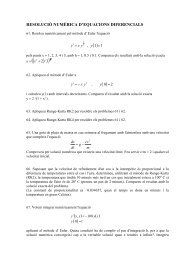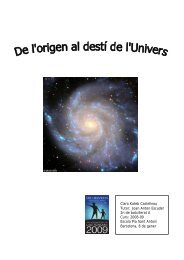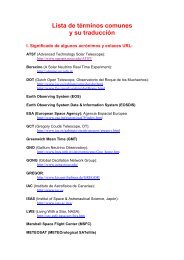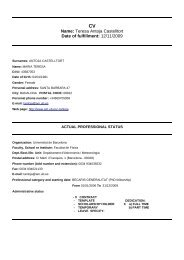Universitat de - Departament d'Astronomia i Meteorologia ...
Universitat de - Departament d'Astronomia i Meteorologia ...
Universitat de - Departament d'Astronomia i Meteorologia ...
Create successful ePaper yourself
Turn your PDF publications into a flip-book with our unique Google optimized e-Paper software.
56 Chapter 2. Multiwavelength approach to LS 5039<br />
DECLINATION (J2000)<br />
-14 49 00<br />
30<br />
50 00<br />
30<br />
51 00<br />
30<br />
52 00<br />
30<br />
LS 5039 V band<br />
LS 5039<br />
ROSAT<br />
53 00<br />
18 26 20 15 10<br />
RIGHT ASCENSION (J2000)<br />
05<br />
Figure 2.10: CCD image of LS 5039 obtained on 1998 June 7 with the 1.52 m OAN<br />
telescope in the V Johnson filter. The circle with 35 ′′ radius represents the 90% confi-<br />
<strong>de</strong>nce position from the ROSAT PSPC pointed observations quoted in M97. The two<br />
comparison stars used for differential photometry are labeled as C1 and C2.<br />
the V band. Differential photometry was performed against two nearby comparison<br />
stars (C1 and C2 in Fig. 2.10).<br />
Based on several observations of Landolt (1992) standards, the adopted magni-<br />
tu<strong>de</strong>s of the comparison stars are V = 12.53, R = 12.01, I = 11.55 and V = 10.10,<br />
R = 9.36, I = 8.68 for C1 and C2, respectively. This absolute photometry is accu-<br />
rate to ±0.03 mag. Relative variations in the final photometric results of Table 2.4<br />
can be nevertheless traced at the ±0.01 mag level.<br />
From our OAN observations we propose that there may be day-to-day variations<br />
with amplitu<strong>de</strong>s of a few hundredths of magnitu<strong>de</strong>. This appears specially evi<strong>de</strong>nt<br />
in the latest two days of Table 2.4. Here, the LS 5039 brightness <strong>de</strong>creased by about<br />
0.04 mag in V and 0.05 mag in R and I from one day to the next. In doing so,<br />
all the differences between the two comparison stars remained constant within less<br />
than 0.01 mag, thus supporting the reality of this variation.<br />
C1<br />
C2






